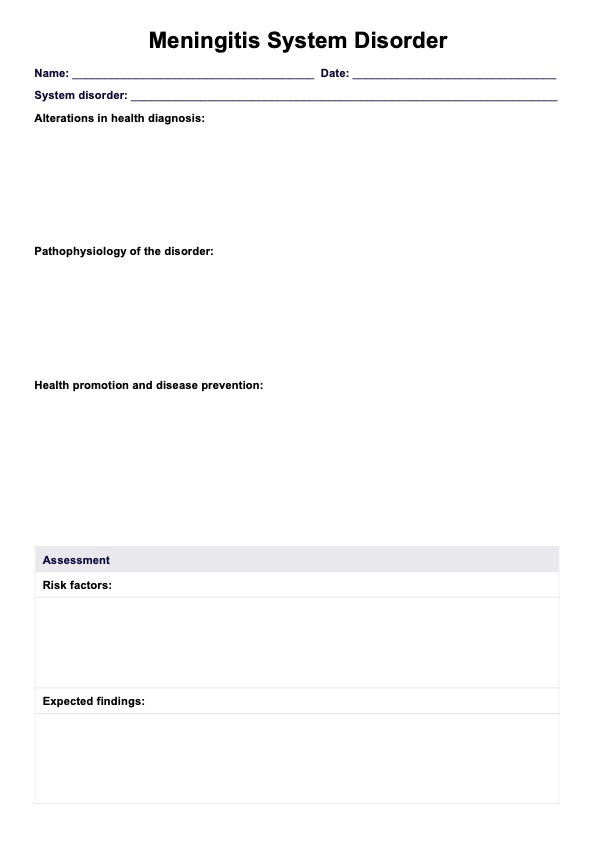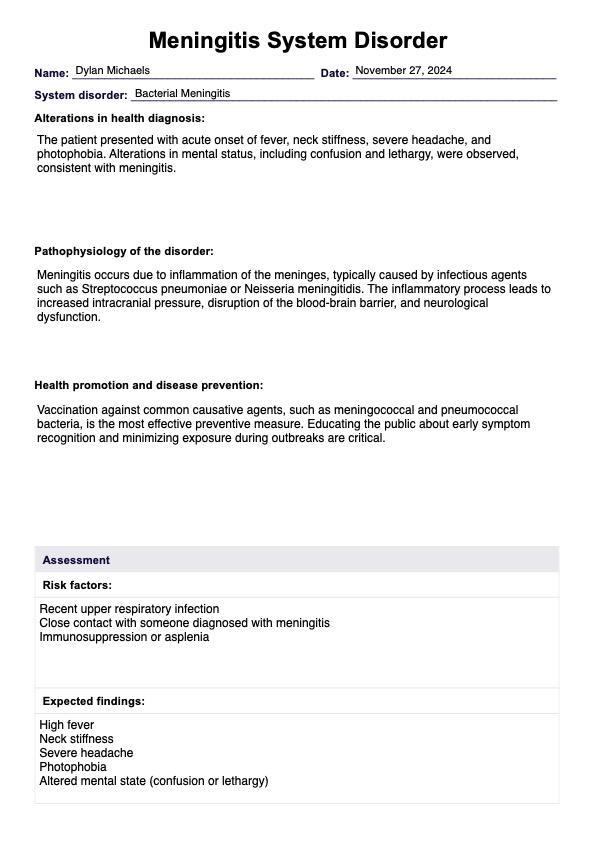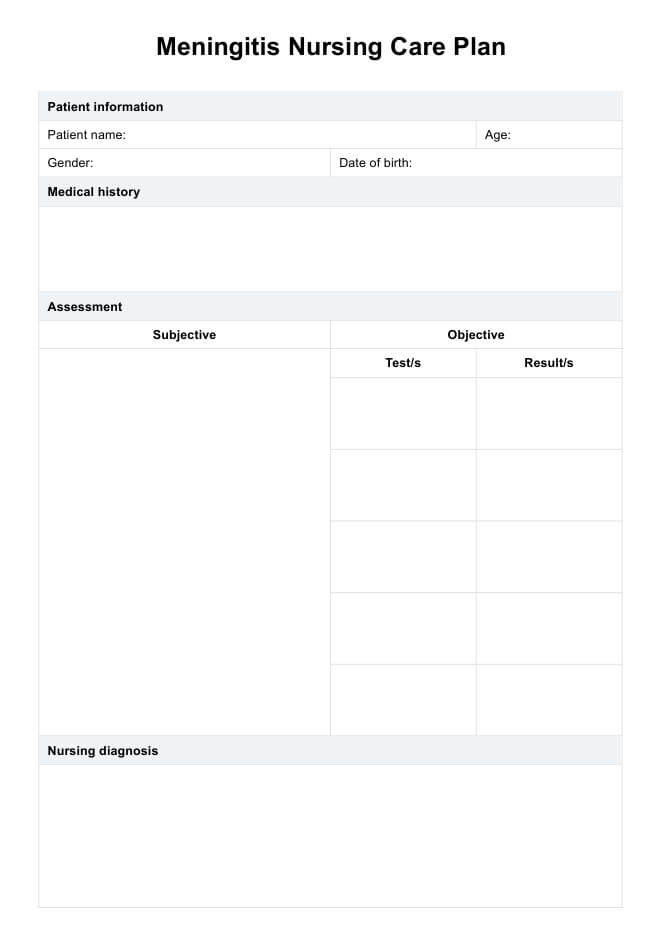Meningitis System Disorder
Download Carepatron's free Meningitis System Disorder Template PDF and example for a structured approach in clinical learning and assessment.


What is a Meningitis System Disorder Template?
Meningitis System Disorder refers to the inflammation of the protective membranes surrounding the brain and spinal cord, typically caused by infection (World Health Organization, 2023). It is considered a severe infectious disease that can be life-threatening without immediate intervention. The disorder can result from various pathogens, including bacteria, viruses, fungi, and parasites. Symptoms often include neck stiffness, fever, headache, and altered consciousness. Poor feeding and poor muscle tone may also be observed in infants.
A Meningitis System Disorder Template is then primarily used as an active learning template for more structured learning of meningitis. These templates typically begin with sections where students or healthcare professionals can write down the pathophysiology related to the client problem, health promotion, disease prevention, and further assessment related to meningitis. The template can also include sections to write down risk factors, expected findings, laboratory tests, diagnostic procedures, and other relevant information.
The template can also include other notes about complications and prevention strategies related to the disorder. For example, timely and complete treatment is crucial to prevent complications such as hearing loss, brain damage, or death. Health promotion strategies can also include vaccination, which offers protection against certain bacterial strains, and public health measures to minimize disease spread.
Meningitis System Disorder Template
Meningitis System Disorder Example
How does our Meningitis System Disorder Template work?
Carepatron’s Meningitis System Disorder Template is designed to assist healthcare professionals in actively learning and managing meningitis cases. Following the structured steps below, medical practitioners and students can maximize this tool in their education and clinical practice.
Step 1: Access the template
The Meningitis System Disorder Template is available directly within this guide. You can click on "Use template" to open and customize it within the Carepatron platform, as this can also be used to study other system disorders. To get a fillable PDF copy, you can also click on "Download".
Step 2: Fill in the sections in the template
Fill in the sections of the template during patient assessment or when studying. Note meningitis as the system disorder, student name for ownership of these notes, followed by alterations in health diagnosis, pathophysiology, and other information.
Step 3: Review the template
After completing the template, review the written information for comprehensiveness and accuracy. You can access current evidence-based guidelines and identify areas for further study. You can also use this tool as a form of self-assessment, and you can seek feedback from instructors for additional information or to identify potential gaps.
When would you use this template?
The Meningitis System Disorder Template is essential for healthcare professionals and students in various clinical scenarios. Its structured approach ensures accurate documentation, better communication, and improved patient outcomes. Below are three key instances where this template proves invaluable:
Assessing risk factors and symptoms
The template is ideal for evaluating patients with signs of meningitis, such as neurologic dysfunction, fever, or stiff neck. Healthcare professionals can use this to document and analyze information for quicker diagnosis. Early detection and intervention can significantly reduce complications and improve patient care.
Educational tool for students
The template serves as an invaluable learning tool for healthcare students by providing a structured framework for understanding meningitis pathophysiology and clinical presentation. Students develop stronger clinical reasoning skills by following the template's systematic approach to patient assessment.
Clinical simulation training
The template provides an excellent structure for simulation-based learning scenarios. During simulated patient encounters, students can practice systematic assessment and documentation while receiving real-time feedback on their clinical reasoning process.
Benefits of using this template
The Meningitis System Disorder Template offers healthcare students and professionals a structured and efficient approach to managing meningitis cases. Below are three key benefits of using this resource:
Comprehensive documentation of client problems
For healthcare practitioners, this template provides a detailed framework for recording patient data. By centralizing information on potential causes like upper respiratory infections or complications from bacterial meningitis, to other aspects of the disorder, healthcare professionals can address the patient problem effectively and ensure all critical aspects are considered.
Supports health promotion and preventative care
Using the template enables practitioners to emphasize health promotion strategies, such as vaccination and early intervention, to reduce the spread of meningitis. By identifying risk factors early, students and clinicians can emphasize the importance of patient education on preventative measures, significantly lowering the likelihood of future infections or outbreaks.
Enhances diagnostic accuracy and patient outcomes
The template guides healthcare professionals and students through critical diagnostic steps, ensuring thorough assessment of symptoms and proper identification of bacterial meningitis. It also supports recognizing atypical presentations linked to meningitis, like those following upper respiratory infections, improving the chances of timely and accurate treatment.
Reference
World Health Organization. (2023, April 17). Meningitis. World Health Organization. https://www.who.int/news-room/fact-sheets/detail/meningitis
Commonly asked questions
The four primary clinical manifestations of meningitis include fever, neck stiffness, altered mental status, and severe headache. These symptoms may appear suddenly and are often accompanied by nausea, vomiting, or sensitivity to light.
The protocol for meningitis includes immediate hospitalization, administration of intravenous antibiotics for bacterial meningitis, and supportive care. Additional steps involve conducting diagnostic tests like lumbar punctures to confirm the infection and determine the appropriate treatment.
Behavioral problems associated with meningitis can include irritability, difficulty concentrating, and mood swings, often resulting from neurological impacts or post-infection complications. In severe cases, these issues may persist long-term, affecting social interactions and daily functioning.
Mental disorders related to meningitis can include depression, anxiety, and cognitive impairments due to inflammation or damage to the brain. These conditions may require ongoing psychological support and therapy to manage effectively.












































































































